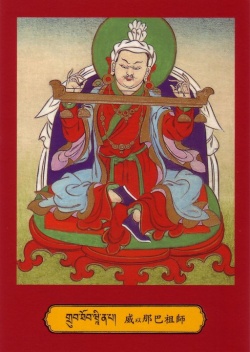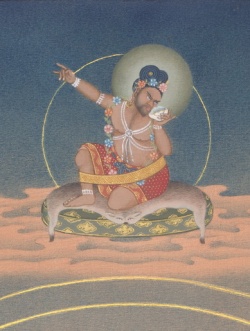Virupa
བི་རཱུ་པ།; Virūpa; Virupa; The Ḍākinī-Master;
Virupa (Skt. Virūpa; Tib. བི་རུ་པ་, བི་ཝ་པ་, Wyl. bi ru pa or bir wa pa) was one of the eighty-four mahasiddhas of India and an important source of the teachings set down in the Lamdré of the Sakya school.
He is also known by the name Tutop Wangchuk (Tib. མཐུ་སྟོབས་དབང་ཕྱུག་, Wyl. mthu stobs dbang phyug).
External Links
Source
Virupa (bir wa pa), one of the Eighty-four Mahasiddhas of India, was born into a royal family one thousand and twenty years after Lord Buddha entered parinirvana. He took novice monk vows and entered the Nalanda monastery, of which he became abbot later. He perfected his disciples of study and meditation.
However, after seventy years of one-pointed tantric practice he had not attained any siddhis of any kind, and actually negative events were happening in his life.
He decided he had no connection with the tantric teachings, Vajrayana, and with this state of mind he threw his rosary into the toilet and stopped doing Deity Meditations.
However, the same night Nairatmya manifested for him, and said:
Noble son, do not act in this way. Pick up your rosary, clean it, and take up your practice again. I am the deity which whom you have a karmic connection to, and I will bestow my blessings upon you".
The following evening Nairatmya appeared to him again in her own mandala of fifteen goddesses, and she bestowed upon him the four specific empowerments, and he reached the first bodhisattva bhumi level including the Path of Seeing.
On the evening of the twenty-ninth day he became a bodhisattva of the sixth bhumi.
The monastic community at Nalanda monastery knew that something strange happened, but they were dubious about the strange behavior of Virupa, and he left the monastery.
This Virupa, the human originator of the Lamdre teachings of the Sakyapa school is however NOT the teacher of the awareness dakini Sukhasiddhi, whose teachings became important in the Shangpa Kagyu tradition.
Sukhasiddhi's Virupa is known as the Eastern Virupa (shar phyogs bir ba pa) or Virupa the Younger (bir ba pa phyi ma), and was a master of various Vajrayogini tantras, particularly of the aspect known as "dbu bcad ma - severed head", which never became very popular in the Tibetan traditions.
Virupa had very special qualities. Seeing that all samsara was suffering, he renounced his station, became a monk and entered the great monastery of Nalanda. He began by studying the Sutrayana teachings and also received and practiced Mantrayana teachings. He became so renowned for his learning that after the passing away of his teacher, he succeeded him as the abbot of Nalanda monastery.
During the day he gave Mahayana teachings to the monks, taught debate, and composed texts. In secret, however, he undertook Mantrayana practices for a very long period of time.
Yet, after practicing in this way for a very long period of time, he experienced no significant signs of progress or accomplishment. Virupa thought that perhaps he did not have the karmic connection with the tantric practice, and so decided to devote his efforts full-time to giving Mahayana teachings.
After making this decision, on that very night, he experienced a vision of Vajra Nairatmya. Vajra Nairatmya said to him: "What you have decided is wrong. I am your karmic link deity and you must continue your vajrayana practices."
So because of this vision, he continued his secret practices. Shortly afterward in his pure vision, he saw the full mandala of Vajrayogini and received the empowerment of the deity Hevajra. Every night for six nights, one after another, he attained great realizations. On the first night he attained the great realization of the first bhumi, realizing the ultimate truth.
On the second night and on each night after it, he obtained one bhumi or one stage of the bodhisattva path, up to the sixth bhumi. He then became a great mahasiddha, left the monastery, performed many great miracles, and subdued those on the wrong path. Many benefitted just by hearing his name, and he did great service to the Buddhadharma.
Virupa had many general followers as well as Mahayana followers, but Krishnapa and Dombipa were the two main followers of his esoteric, pith instruction. For the benefit of Krishnapa, he gave the teaching known as "Vajra Words."
This very short teaching contains the essence of all the Tripitaka and Vajrayana. In the same way that butter is refined from milk, the Vajra Words are the most important essence of the Buddha's sutric and tantric teachings in the form of pith instruction. This teaching then passed to his close disciple Krishnapa, who gave it to his disciples. In this way it was passed on to five great Indian gurus.
The fifth of these gurus was the Gayadhara who came to Tibet several times and gave this teaching to the great translator Drogmi Lotsawa. Drogmi Lotsawa was the first Tibetan to receive the Lam Dre teaching.
He was a great master who had many male and female disciples who had very great realizations. Drogmi Lotsawa transmitted the general tantra explanations and the pith instructions to his disciples separately.
He would not give the general tantric explanations to the disciples who were listening for the pith instructions, and he would not give pith instructions to those who were listening for the general teachings. Among his disciples who received the most important teachings was Seton Kunrik. Seton Kunrik received the Lam Dre teachings, attained high realizations, and gave the teachings to Zhangton Chobar.
Zhangton Chobar was a kind of hidden yogi: to the general public he was an ordinary person working in other people's fields. He promised to work in many fields, and emanated his body to many places.
Zhangton Chobar gave the teaching to the great lama Sakyapa, who was born of the Khon race.
he Buddhist tantric master Virupa (ca. seventh–eighth centuries) is one of the most famous of the eighty-four great adepts or mahasiddhas of ancient India.
Many of these eccentric yogins were the original spiritual ancestors of the Vajrayana teachings that are so important in Tibetan Buddhism.
Virupa was the first human master of the Path with the Result, or Lamdre, which is the fundamental system of tantric practice in the Sakya tradition of Tibet.
The goddess Vajra Nairatmya (who is the consort of Hevajra) first gave the Lamdre teachings to Virupa. He then formed her transmission into the Vajra Lines, which became the basic text of the Lamdre.
This originally oral instruction is treasured as the essential expression of the profound teachings of the Hevajra Tantra and other associated tantric scriptures.
Several masters of the Lamdre tradition in Tibet have written biographies of Virupa, each filled with miraculous events and strange expressions of crazy wisdom.
These texts also provide fascinating glimpses into the religious culture of medieval India. Historical evidence for some of the social phenomena mentioned in Virupa’s story has come to light, such as old Hindu statues with Buddhist images attached to the tops of their heads, and descriptions by travelers in India and Nepal of the suicidal practice of some non-Buddhists who impaled themselves on huge tridents as offerings to their gods.
It is particularly interesting that some Tibetan masters offer symbolic interpretations of Virupa’s acts, connecting them to inner events in the process of tantric yoga. For example, according to the external narrative, Virupa is most famous for preventing the sun from setting and for turning back the flow of the Ganges River.
Ngorchen Könchok Lundrup (1497–1557) explains these events as Virupa’s arrest of the sun of the true nature of mind in the sky of the subtle central channel of the bodyd as his reversal of the flow of the drops of enlightenment mind, which were then retained in the cakra at the crown of his head.
Other episodes in Virupa’s tale are quite violent, such as his repeated destruction of giant phallic images (linga) of the great god Shiva (called Maheshvara or Ishvara in the story), to which human and animal sacrifices were made by non-Buddhist worshipers, and his smashing of a stone image and trident of the terrible goddess Candika, whose victims were devoured in cannibalistic feasts.
Again, there is historical evidence for such practices in ancient India. But Ngorchen also offers an esoteric interpretation of these deeds, speaking of how Virupa smashed the phallic images of the knots in the subtle channels of the body and subdued the Candika goddess of dualistic attachment to subject and object.
The great Jamyang Khyentse Wangpo (1820–92) describes the same events as the destruction of the phallic images of ordinary conceptual thought, which Virupa then reassembled as sublime meditative concentrationd as his defeat of the Candika goddess of the conceptual extremes of eternalism and nihilism by means of the deliberate behavior of ineffable truth. Further episodes in the story can also be understood on different levels.
The story of Virupa translated here is an unusual one, even among the various Tibetan versions that have survived through the centuries.
The author, Chagen Wangchuk Gyaltsen, was a disciple of Pakpa Lodrö Gyaltsen (1235–80), the seventh throne holder of Sakya, from whom he received the transmission of the Lamdre in the Sakya tradition.
From the female teacher Machik Nyitri, he also received these teachings in the Shama tradition of the great yogini Machik Shama (10621149).
Chagen is said to have had a powerful vision of Virupa and to have composed many texts on the Lamdre teachings. He wrote this story of Virupa’s life in 1304, apparantly including information from both lineages he had received.
Many aspects of Chagen’s biography of Virupa are very different than other such works in the Lamdre tradition. More about Virupa’s life and teachings is found in my Taking the Result as the Path (Wisdom Publications, 2006), which also contains a translation of the biography of Virupa written by Jamyang Khyentse Wangchuk (1524–68).
The following translation was made from a photocopy of an ancient Tibetan manuscript entitled Cha rgan gyis mdzad pa’i rnal ’byor dbang phyug gi lo rgyus. The original text is written in cursive dbu med script and is 12 folios (24 pages) long.
The same work was recently input into a computer and published in Nepal for the first time in Sa skya pa’i bla ma kha shas kyi rnam thar (Sa skya rgyal yongs gsung rab slob gnyer khang: Kathmandu, 2003), pp. 51–74. I have also consulted this new version, which contains some editorial changes. The Tibetan text is somewhat corrupt and contains many archaic terms and expressions.
Thus, the translation of a few words and phrases is tentative. I have usually standardized the spellings of names and places in accordance with more generally accepted forms and have added section headings into the translation.

